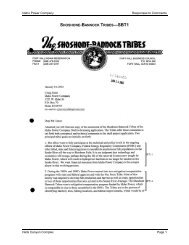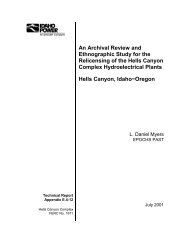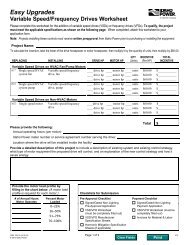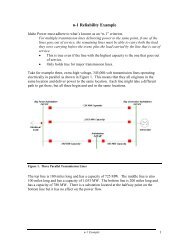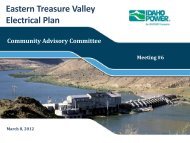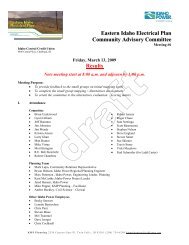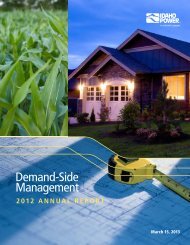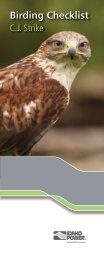Assessment of Chukar and Gray Partridge Populations - Idaho Power
Assessment of Chukar and Gray Partridge Populations - Idaho Power
Assessment of Chukar and Gray Partridge Populations - Idaho Power
- No tags were found...
You also want an ePaper? Increase the reach of your titles
YUMPU automatically turns print PDFs into web optimized ePapers that Google loves.
Hells Canyon <strong>Chukar</strong> <strong>and</strong> <strong>Gray</strong> <strong>Partridge</strong> Report, Ratti <strong>and</strong> Giudice 264.6.2. <strong>Gray</strong> <strong>Partridge</strong>We found no published reports on food habitats <strong>of</strong> gray partridge inhabiting canyongrassl<strong>and</strong>s. The following summary is based on studies conducted in agricultural l<strong>and</strong>scapes inNorth America.<strong>Gray</strong> partridge are opportunistic, thus a variety <strong>of</strong> foods are consumed including seeds <strong>of</strong>domestic crops (wheat, barley, oats, corn, <strong>and</strong> sunflower) <strong>and</strong> weeds in cropfields (foxtail [Seatiaspp.], wild buchwheat [Polygonum spp.], ragweed [Ambrosia spp.], <strong>and</strong> Russianthistle [Salsolakali]) (Kobriger 1980, Melinchuk 1981, Hupp et al. 1988). The most important animal foods foradults in the northern plains include Orthoptera <strong>and</strong> Lepidoptera. Insects are important in earlydiet <strong>of</strong> chicks <strong>and</strong> include leafhoppers (Cicadellidae), flies (Diptera), ants (Formicidae),grasshoppers <strong>and</strong> crickets (Orthoptera), plant bugs (Miridae), sawfly larvae (Hymenoptera),Lepidoptera larvae, Carabidae, Staphylinidae, <strong>and</strong> cereal aphids (Aphidae) (Erpelding et al.1987, Kobriger 1980, Potts 1986, Hupp et al. 1988). Diet varies by season: mostly insects insummer, seeds <strong>of</strong> wild plants in fall, seeds <strong>of</strong> crop plants in winter, <strong>and</strong> green leafy vegetationduring spring (Carroll 1993).4.7. Movements4.7.1. Daily Movements <strong>and</strong> Home RangesHome range is the area used by an animal during a specified time period to satisfy food,cover, <strong>and</strong> reproductive requirements, excluding infrequent exploratory movements (Burt 1943,Walter 2000). Individual home ranges <strong>of</strong>ten are variable. Variability in home ranges may reflectdifferences in social status, season, weather, <strong>and</strong> l<strong>and</strong>scape characteristics (Smith et al. 1982).Furthermore, comparisons among studies should be viewed with caution due to differences inacquiring <strong>and</strong> analyzing home-range data.4.7.1.1. <strong>Chukar</strong>. Estimates <strong>of</strong> daily movements <strong>and</strong> home ranges <strong>of</strong> chukars inNorth America are limited. Anecdotal observations suggested that chukars frequently moved 1-3mi/day (Bump 1951 <strong>and</strong> Phelps 1955, cited in Christensen 1996; Oelklaus 1976). Duringsummer <strong>and</strong> early fall, daily movements <strong>of</strong>ten involved movements up <strong>and</strong> down the canyonwalls (Oelklaus 1976). Estimates from 2 radio telemetry studies indicated that daily movements<strong>and</strong> home ranges were much smaller than previously thought. Lindbloom (1998) reported thataverage daily movement <strong>of</strong> chukars in the Salmon River drainage during March-August was 280m (n = 19, SE = 44.5, range: 32-686), but no radiotagged birds moved from higher elevations tolower elevations near the river’s edge. Average daily movements were similar between seasons(spring <strong>and</strong> summer) <strong>and</strong> sexes. Average distance between chukar locations <strong>and</strong> permanentwater was 1,103 m (n = 31, SE = 95, range: 157-1,901). Average spring-summer home rangewas 39.8 ha (100% MCP method; n = 20 birds, 5-16 locations/bird; SE = 5.0, range: 6.0-78.8),which was similar between years <strong>and</strong> sexes. Walter (2000) reported that average dailymovement in eastern Oregon during April-August was 282 m (n = 17, SE = 11.2, range: 181-415) <strong>and</strong> average spring-summer home range was 17-25 ha (90% MCP <strong>and</strong> 70% AK methods; n= 13 birds, >25 locations/bird). However, both Lindbloom (1998) <strong>and</strong> Walter (2000) cautionedthat their studies were conducted during years <strong>of</strong> relatively high precipitation. Thus, chukars didnot need to move great distances between habitats supporting food <strong>and</strong> water (Lindbloom 1998).



